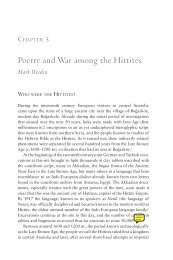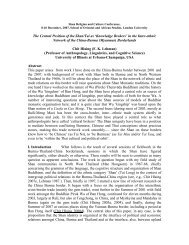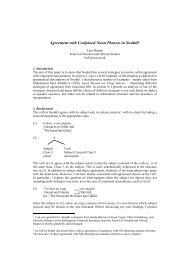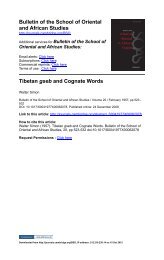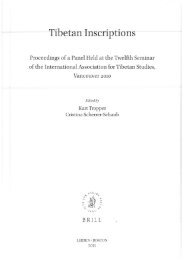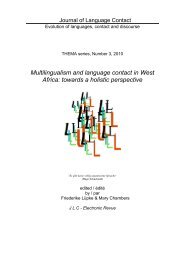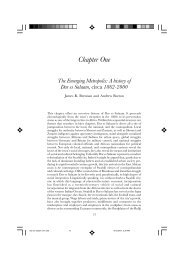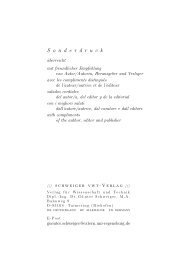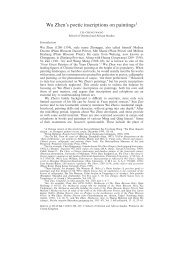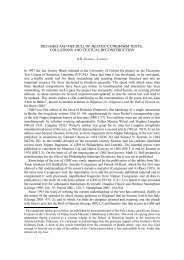In search of the é . d u b . b a . a : the ancient Mesopotamian school ...
In search of the é . d u b . b a . a : the ancient Mesopotamian school ...
In search of the é . d u b . b a . a : the ancient Mesopotamian school ...
You also want an ePaper? Increase the reach of your titles
YUMPU automatically turns print PDFs into web optimized ePapers that Google loves.
George/6<br />
was <strong>the</strong> most skilled student in his class. 12 This claim is not unique and may have been<br />
an expression <strong>of</strong> an ideal ra<strong>the</strong>r than a reality, 13 but in later life ∞ulgi was certainly an<br />
enthusiastic patron <strong>of</strong> <strong>the</strong> arts. If he did not himself found <strong>the</strong> academies <strong>of</strong> Sumerian<br />
learning at Ur and at Nippur, he clearly adapted <strong>the</strong>m to his purpose, speaking <strong>of</strong> his<br />
‘libraries’ (g ì r . g i n . n a ) set up for <strong>the</strong> use <strong>of</strong> court minstrels (∞ulgi Hymn B 318 and<br />
329). The aim was evidently to provide a reliable corpus <strong>of</strong> Sumerian songs and o<strong>the</strong>r<br />
texts for future generations. Thus ∞ulgi envisaged that hymns to his glory and o<strong>the</strong>r<br />
courtly literature <strong>of</strong> his day would be preserved for posterity. Evidently he was worried<br />
that as <strong>the</strong> Sumerian language died out <strong>the</strong> songs, hymns and o<strong>the</strong>r compositions written<br />
in it would be forgotten — and with <strong>the</strong>m his glorious memory. And so <strong>the</strong>y were not<br />
forgotten, for his academies established a literary corpus that survived as <strong>the</strong> core <strong>of</strong> <strong>the</strong><br />
scribal curriculum at Nippur, Ur and o<strong>the</strong>r cities for three centuries.<br />
When ∞ulgi speaks <strong>of</strong> his state-sponsored academies at Nippur and Ur as<br />
<strong>é</strong> . g <strong>é</strong> · t u g . d n i s s a b a . m u l , ‘House <strong>of</strong> Wisdom <strong>of</strong> Starry Nissaba’, and k i . ú m u n ,<br />
‘Place <strong>of</strong> Learning’, it seems to me he is using <strong>the</strong> expressions much as one used <strong>the</strong><br />
ceremonial names <strong>of</strong> temples. With institutions that could bear such distinctive names he<br />
surely had in mind physical structures dedicated to <strong>the</strong> scribal art. Thus I would maintain<br />
that <strong>the</strong> <strong>é</strong> . d u b . b a . a <strong>of</strong> <strong>the</strong> Edubba-literature was an architectural as well as an<br />
institutional reality. <strong>In</strong> contrast to <strong>the</strong> Old Babylonian <strong>school</strong>s described earlier, we can<br />
suppose that <strong>the</strong>se grand imperial <strong>school</strong>s occupied purpose-built accommodation,<br />
whe<strong>the</strong>r whole buildings or complexes <strong>of</strong> rooms.<br />
It is not difficult to imagine that scribal training in <strong>the</strong> Ur III period came, like so<br />
much else, under <strong>the</strong> control <strong>of</strong> <strong>the</strong> state. 14 Documentation reveals that provincial<br />
governors had responsibility for <strong>the</strong> upkeep <strong>of</strong> learner scribes in local centres. 15<br />
Connections between state and <strong>é</strong> . d u b . b a . a were strong. 16 Certainly <strong>the</strong> courts <strong>of</strong> <strong>the</strong><br />
kings <strong>of</strong> Ur and <strong>the</strong> succeeding dynasty <strong>of</strong> Isin were witness to considerable literary<br />
creativity in Sumerian. The <strong>é</strong> . d u b . b a . a was an important instrument not only for<br />
handing down traditional texts but also for producing new royal compositions. Hymns<br />
were composed articulating <strong>the</strong> imperial pretensions <strong>of</strong> <strong>the</strong> first six kings <strong>of</strong> Isin and a few<br />
<strong>of</strong> <strong>the</strong> later ones, and several <strong>of</strong> <strong>the</strong>m were included in <strong>the</strong> basic curriculum <strong>of</strong> <strong>the</strong> scribal<br />
trainee. 17<br />
This suggests that <strong>the</strong> state <strong>é</strong> . d u b . b a . a <strong>of</strong> <strong>the</strong> Ur III period was maintained in some<br />
form by <strong>the</strong> court <strong>of</strong> Isin for as much as one and a half centuries after <strong>the</strong> fall <strong>of</strong> Ur, an<br />
12 See ∞ulgi Hymn B 13–20, re-edited by Volk 1996: 202–3, fn. 148; cf. Klein 1981a: 15.<br />
13 Note <strong>the</strong> similar passage in a hymn <strong>of</strong> I·me-Dag®n <strong>of</strong> Isin: Ludwig 1990: 166 ff., I·D VA 5–9.<br />
14 See already Nissen 1993: 108, who considers it ‘conceivable that <strong>the</strong> sector <strong>of</strong> scribal education<br />
formerly supported by private initiative increasingly came under state influence during <strong>the</strong> Ur III period’.<br />
15 At Girsu <strong>the</strong> governor provided regular rations for twelve scribal apprentices (d u b . s a r t u r . t u r):<br />
see Waetzoldt 1986: 39, 1989: 39.<br />
16 Cf. Kraus 1973: 24–5, who argues for a close relationship between <strong>the</strong> <strong>é</strong> . d u b . b a . a and <strong>the</strong> courts<br />
<strong>of</strong> <strong>the</strong> successor states <strong>of</strong> <strong>the</strong> early second millennium, speaking <strong>of</strong> <strong>the</strong> <strong>é</strong> . d u b . b a . a as a ‘H<strong>of</strong>kanzlei’.<br />
17 The group <strong>of</strong> four literary texts first encountered by Old Babylonian <strong>school</strong>boys, called <strong>the</strong> ‘Tetrad’ by<br />
Tinney 1999: 162–8, contained three hymns to kings <strong>of</strong> Isin, Iddin-Dag®n B, Lipit-I·tar B and Enlil-b®ni<br />
A.



